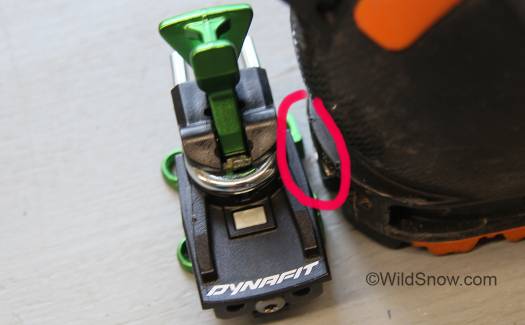Is it Christmas, or just a rainy August day here in the old Colorado mining town? I heard a bump on the porch. Could have been Santa dropping off a lump of coal left behind by the miners. Or, have I been a good enough by to avoid Santa tossing lumps of carbon at our door? Turns out, yeah, life is ok (Lisa, your comments?). Box from Germany with the full-on retail version of Dynafit Superlite 2.0 — The Green Mo’chine. Added bonus, a brand spanking new pair of retail version Radical 2.0 30 year golden eagles. Had to show those, to prove it really is Christmas.

Green Machine in all its lack of mass. Dynafit Superlite 2 backcountry ski touring binding has removable brake.

The on-off push button brake appears exceedingly excellent. The one pictured here only works to about 80 mm but easily modified and we suspect Dynafit will release at least one other size brake size for this winter if they sell many of these things. Their catalog for 2015-2016 shows brake sizes 75mm, 90mm, 105mm, so perhaps all widths will be available sooner than later. After all, isn’t it Christmas already?
Aha, you say, but what about that pesky heel-flat-on-ski mode that North American skiers seem to need much more than German binding designers? The way to compare: normalize by measuring distance of boot heel above ski while in flat resting mode compared to toe pin height (this doesn’t translate to any particular angle, it’s just a basis for comparison).
Dynafit Speed Radical shows 25 mm toe fittings height vs 13 heel, a difference of negative (heel dropped) 12 mm, resulting in a pleasantly neutral heel-flat mode. That’s a pretty normal heel-flat mode for a tech binding.
Dynafit Superlite 2.0: With heel unit spun around and flip lifter stowed so your boot heel is resting on binding housing (lowest Dynafit approved mode), Superlite 2.0 measures 29 mm toe height vs 31 heel, a difference of positive 2 mm in heel height.
In other words, Superlite brings you up off the flat mode by posting you about 14 mm higher at the heel than Speed Radical. It does NOT provide a heel-flat-on-ski mode.
What’s that in real life?

As you can see above, the lower recommended climbing heel lift configuration for Superlite 2 is decidedly not neutral. Nonetheless, it is noticeably lower than the “medium” angle on something such as a Speed Radical, so unless you’re on flat ground it’ll be totally adequate and might even be a nice angle for moderate terrain. Sort of an ‘in between’ compared to totally flat and what we normally consider to be ‘medium’ height.
Stats from the retail version of this super interesting binding:
Total weight with screws, no brake, no crampon mount: 196 grams.
Heel weight, no screws: 100 grams.
Toe weight, no screws: 80 grams.
Brake, 80 mm max ski width: 80 grams.
Difference between toe and heel height in downhill mode, measured to center of binding pins: 7 mm, which is 5 mm less ramp/delta than classic TLT and 7 mm less than Speed Radical. Numbers aside, the ramp-delta of Superlight 2 is noticeably reduced in comparison to many other tech bindings.
Note that forward (upward) release on this binding is fixed by a U-shaped spring that is not adjustable. It is said to be around release value of 9. Side release IS ADJUSTABLE, numbers printed on binding show 6 to 12. In Europe last winter I got the impression they were going to make a lighter “women’s” spring available but I’ve not seen a SKU for that. It may not be imported or perhaps they decided not to sell it in U.S. That’ll be easy to find out about in coming weeks.

The binding appears to have a high lift, but when the flipper is in that position it doesn’t end up under the boot heel.

Superlite high lift is similar to medium lift of Dynafit Radical. Nearly every skin track in Europe is set at these angles, but skin tracks can be quite steep in certain regions. If you need higher lift you know who you are. Thing is, the Superlite lifter looks incredibly easy to mod for more lift.
WildSnow.com publisher emeritus and founder Lou (Louis Dawson) has a 50+ years career in climbing, backcountry skiing and ski mountaineering. He was the first person in history to ski down all 54 Colorado 14,000-foot peaks, has authored numerous books about about backcountry skiing, and has skied from the summit of Denali in Alaska, North America’s highest mountain.


